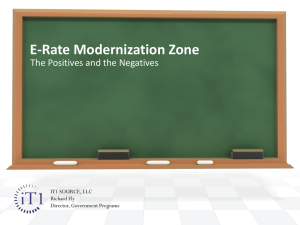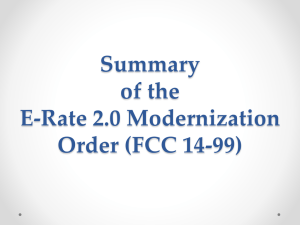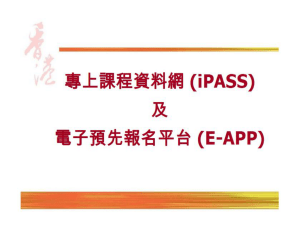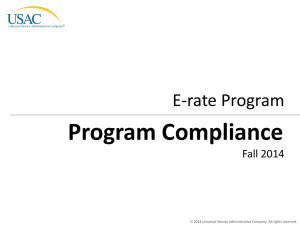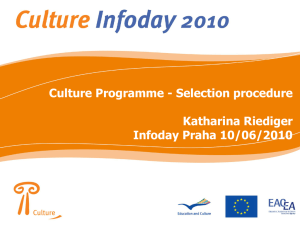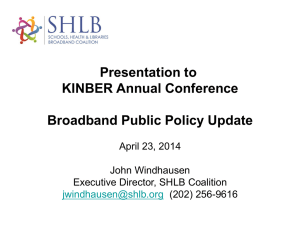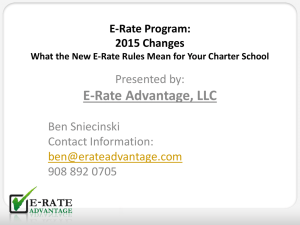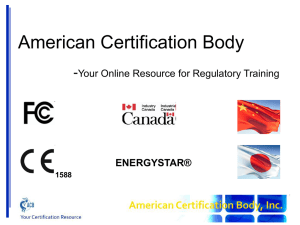PowerPoint
advertisement
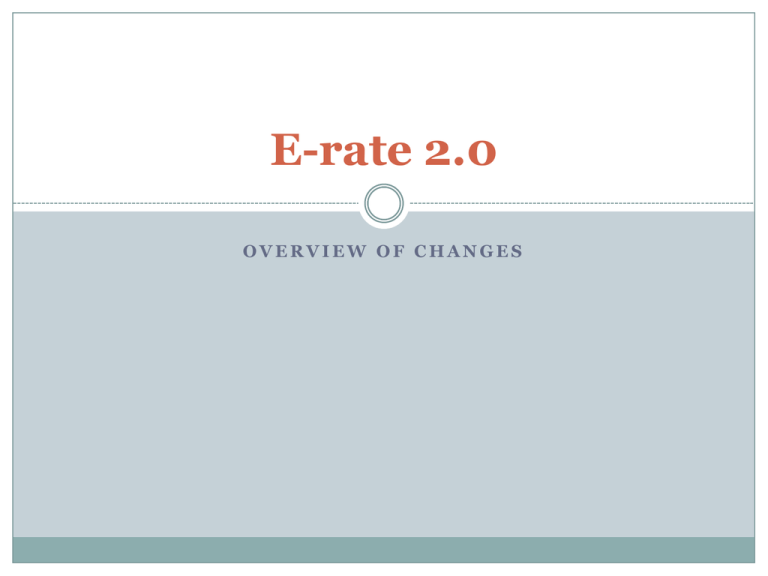
E-rate 2.0 OVERVIEW OF CHANGES Overview Framework for Reform Connectivity Goals Discount Calculation Changes Priority 1 Changes Priority 2 Changes Invoice Changes Program Streamlining Measures Cost Effectiveness Efforts Increased Accountability Tribal outreach Further Notice of Proposed Rulemaking History In July 2013, FCC released Notice of Proposed Rule Making (NPRM) seeking comments on various proposed reforms In December 2013, Tom Wheeler became FCC Chairman, vowing to modernize E-rate I March 2014, FCC issued Public Notice seeking more focused comments on proposed E-rate reforms On July 11, 2014 FCC voted 3-2 to adopt proposed reforms On July 23, 2014, 162+ page Order was released, providing details on E-rate program changes 50,000 Foot View Focus E-rate on funding broadband connectivity to buildings and inside buildings Accomplish program overhaul without increasing the funding cap Limited funds means there are hard choices Phase out voice services and end funding of other legacy services beginning FY 2015 Ambitious broadband connectivity goals Establish P2 budgets per student (minimum amount per building) to allow all applicants to receive funding for equipment inside buildings P2 funding limited to broadband infrastructure and equipment, no more voice or video equipment eligibility Streamline program requirements to issue funding approval letters more timely Share data about pricing and connectivity levels to promote better pricing Short Term Pain for Long Term Gain The Pain: In FY 2015 certain Priority 1 services not deemed essential for broadband connectivity will no longer be eligible Phase down of voice telecommunication services funding begins in FY 2015, 20 discount percentage points per year Very narrow Wireless data plans eligibility The Gain: All schools will have access to P2 Dedicated $1 Billion annual fund for Wi-Fi equipment Apply based on budgets amounts of $150 per student/$9200 per building minimum so no applicant receives disproportionate funding FCC projects it will cost $5 Billion over 5 years to fund all applicant’s Wi-Fi equipment projects Streamlining procedures to ease application process Connectivity Goals Internet WAN Connections Internal Connections Internet Connectivity Goals Schools Internet access of at least 100 Mbps per 1,000 students and staff (users) in the short term 1 Gbps Internet access per 1,000 users in the long term Measurement will be at the district level for school districts and school level for schools that are not part of a district WAN Broadband Connectivity Goals Schools Dedicated data service scalable to 10 Gbps per 1,000 students in the long term FCC assumes that in most cases, a 1 Gbps fiber connection can be readily scaled to 10 Gbps with upgraded networking Internal Connections Goals No goals set at this time because more information is needed FCC staff will conduct a survey of schools and libraries to determine the sufficiency of their LAN/WAN capacity and coverage Specific goals will be developed at a later time Discount Calculation Changes District Wide Discount Calculations Library Discount Calculations Rural/Urban Calculations Income Surveys Community Eligibility Provisions of NSLP District-Wide Discount Calculations All discounts will be calculated on a district-wide simple average basis Total district NSLP eligible students/total district enrollment Example School Rural/Urb an Enrollment NSLP eligibility Plainfield Elementary Jacksonville Middle School U 210 120 U 195 95 Newville High School U 201 115 Total U 606 330 330/606=54.4% NSLP eligibility District-Wide Discount=80% Library Discount Calculation Library systems that have branches or outlets in more that one public school district will use the address of the central outlet or main administrative office to determine which public school district the system is in Use school district’s discount application to central outlet or main office when applying as a library system or on behalf of individual libraries within that system New Urban/Rural Definition Current rural/urban county classifications no longer in use for FY2015 2010 U.S. Census will be used instead Urban applicants are those with addresses in an ”urbanized area” or “urban cluster” Urbanized area has 50,000 or more people in a densely settled core of census tracts Urban clusters are adjacent to an urbanized area and has at least 2,500 people All areas that are not considered “urban” are classified as rural Rural/Urban status of majority of buildings (physical addresses) will be used for entire district Question asked of FCC: What if a district has two buildings, and one has a rural address and the other has an urban address? Full list of urban areas at http://www2.census.gov/geo/ua/ua_st_list_all.xls. If your town is NOT on this list, then it is considered rural. (subject to verification with FCC) Surveys Income survey results can no longer be extrapolated Discounts will only be based on the income surveys actually collected Community Eligibility Provision CEP program provides a new alternative to NSLP household applications for free and reduced price meals in high poverty LEA’s No longer required to obtain individual income eligibility applications from each student NSLP estimates are derived from existing data from other income-based programs A school, group of schools, or the entire district must have an identified Student Percentage of 40% or more and must offer both breakfast and lunch daily to qualify for CEP For E-rate, CEP schools will use the 1.6 multiplier as is currently permitted by USDA and other federal programs Presumably, the NSLP eligibility data that will be entered into the Form 471. Block 4 discount calculation worksheet will already contain the 1.6 multiplier CEP schools must retain back-up calculations which may be requested during PIA and audits The previous FCC guidance that CEP schools must use the NSLP data from the year before they opted into CEP has been repealed Priority 1 Changes Name Change New ineligible Services Phase out of Voice Services Wireless Data Plans Bidding Exemption for Certain Bundled Internet Service Bundled End-User Equipment Priority One Overview Traditional Priority 1 will be called Category 1 Category 1 will be fund broadband connectivity and Internet access to buildings Category 1 services will be funded first before Category 2 equipment and services are funded in order to ensure there is enough funding available to cover all Category 1 funding requests Priority 1 Service Eligibility Changes Beginning in FY2015, paging, webhosting, certain telephone service components and e-mail will no longer be eligible Beginning in FY2015, all voice services will begin to be phased out by 20 discount percentage points/year -This includes cellular voice, local and long distance, PRI service, and hosted VOIP service -No voice services will be eligible beginning with FY2019 Cellular data and mobile cellular broadband services subject to strict cost effective scrutiny Voice Phase Out Schedule If Your District Discount is: FY 2015 FY 2016 FY 2017 FY2018 FY2019 No Funding No Funding No Funding No Funding No Funding No Funding No Funding No Funding No Funding No Funding No Funding No Funding No Funding No Funding No Funding No Funding No Funding No Funding No Funding No Funding No Funding No Funding 20% No Funding 25% 5% 40% 20% 50% 30% 10% 60% 40% 20% 70% 50% 30% 10% 80% 60% 40% 20% 90% 70% 50% 30% 10% No Funding Wireless Data Plans Cellular data plans and mobile broadband services (such as wireless services to an iPad or aircards) are no longer eligible in buildings that have Wi-Fi access In buildings without Wi-Fi: These services are only eligible upon showing that the individual data plans are the most cost effective option for providing internal broadband access for portable mobile devices Must prove either that installing a WLAN is not physically possible, or provide a comparison of the costs of individual data plans vs. installing a WLAN solution Be prepared for extensive cost effectiveness review from PIA Library bookmobiles are an exception to heightened review Voice Telephone Service Components Ineligible as of FY2015 Directory assistance charges Text messaging Custom calling services Direct inward dialing (DID’s) 900/976 call blocking Inside wire maintenance plans All such charges must be deducted from both the pre-discount cost included on the Form 471 and all associated vendor or applicant reimbursement invoices (SPIs and BEARs) for 2015 invoices Such charges do NOT have to be deducted for FY2013 or FY2014 BEARs of SPIs Bidding Exemption for Bundled Internet “Commercially available” Broadband/Internet packages that cost less than $300 per month per building (prediscount) are now exempt from the Form470 competitive bidding requirements for FY2015 Minimum speed must be 100 Mbps downstream and 10 Mbps upstream Cost must be based per building and cannot be averages across multiple buildings Annual cost of $3600 must include all equipment and installation charges and monthly recurring charges Applicants must still submit a Form 471 application for funding each year Priority 1 Bundled Equipment Limitations Beginning in FY2015, equipment is not permitted to be bundled at no cost with an eligible service This includes free cellular phones, iPads/tablets, and VOIP equipment Applicants will be required to perform a cost allocation to remove the value of the ineligible equipment form the pre-discount price claimed for the annual service costs Previously signed contracts are not grandfathered This rule resulted from an FCC Order in May 2014 and is not technically in the July Reform Order Priority 2 Changes Name Change National Funding Amounts Discount Matrix Change Budgets for Funding Requests Service/Equipment Eligibility Changes April 1 Installations Preferred Master Contracts Technology Plans Priority 2 Overview Traditional Priority 2 will be called Category 2 Category 2 will fund Wi-Fi and related infrastructure and equipment Category 1 services will be funded first in order to ensure there is enough funding available to cover all Category 1 funding requests Category 2 annual budget target is $1 Billion each year (at minimum) Should not enough funding be available to cover an entire discount band, pro-ration will be applied using the NSLP percentage (100% NSLP funded first, then 99%,98%,etc) Priority 2 Discount Matrix Changes Maximum Category 2 discount will change from 90% to 85% All other discount bands will remain the same NSLP Eligibility Urban Rural Less than 1% 20% 25% 1 – 19 % 40% 50% 20 – 34% 50% 60% 35 – 49% 60% 70% 50 – 74% 80% 80% 75 – 100% 85% 85% Priority 2 Predictability Not all applicants will be funded in the year in which they apply There is no provision to allow applicants to spend funds and be reimbursed in a later year Intent of FCC to connect 10 million students each year in FY2015-FY2019 FCC Chairman: “All schools and libraries will have access to P2 funding once every 5 years.” Category 2 Funding Budgets Each school building will be permitted to apply for a pre-discount cap of $150 per student, or a minimum building cap of $9200, over a rolling five-year basis Money is allocated per building (not on a districtwide basis), and applicants cannot move funding from one school to another Funding may be requested over 5 years, or applied for in a single year -Annual application is required and funding approval is subject to available funds each year Category 2 Funding Budgets (Cont’d) If an applicant requests less than the maximum budget available for a building in a single year, the applicant may request the remaining balance in subsequent years of the five-year cycle No look-back provision for applicants funded in years prior to FY2015 All competitive bidding requirements will continue to apply and applicants can only apply for what they need -Possible Preferred Master Contract bidding exemption Priority 2 Eligibility Changes Beginning in FY2015, Priority 2 eligible services will become focused solely on Wi-Fi and building infrastructure and networking Certain equipment and services will be permanently eligible Other equipment and services will be eligible for FY2015 and 2016 and may sunset unless FCC extends eligibility for FY2017 and beyond Other equipment currently eligible will no longer be eligible -Voice components -Video components -Most servers Category 2 Permanently Eligible Items Routers Switches Wireless Access Points Internal Cabling Racks Wireless Controller Systems Firewall Services UPS Equipment Software to Support Eligible Equipment Cloud Based Functionality of this Equipment Category 2 Eligibility in FY2015 and 2016 Caching functionality – necessary software or equipment such as caching servers (brand new) Managed Internal Broadband Services (MIBS)(including managed WiFi) which cover the operation, management, or monitoring of a LAN or WLAN -Obtain LAN’s/WLANs as a service typically for a period of three to five years from third party that manages, operations and maintains network; or, -Own the equipment, but have a third party manage it for applicant Basic Maintenance Services for eligible equipment -But for the maintenance at issue, the internal connection would not function and serve its purpose with the degree of reliability ordinarily provided in the marketplace to entities receiving such services Applicants are allowed to apply for up to $30 per year per student for these services and agree to a 5 year budget Unless FCC extends eligibility, these items will sunset eligibility at the end of FY2016 -Exception to Sunset: Applicants that received funding approval in FY2015 and/or FY2016 for these items may continue to obtain funding for FY2017-FY2019 Category 2 – Non-Instructional Facilities Non-Instructional Facilities are not eligible for equipment unless the NIF has classrooms or the NIF houses the WAN/WLAN central equipment such as the network operations center) For NOCs, applicants must allocate a portion of each school’s $150 budget toward the purchase of such equipment Category 2 – New Schools New schools may estimate the number of students who will be attending the new school and seek funding based on that estimate However, if an applicant overestimates the number who enroll in that school, it must return to USAC by the end of the next funding year any excess funding based on the actual number of enrolled students Category 2 – Students in Multiple Schools Students who attend multiple schools, such as those that attend Cooperative Districts of CTCs part-time, may be counted by both schools in order to ensure appropriate LAN/WLAN deployment for both buildings Category 2 – Early Installation Eligible equipment may be purchased and/or installed on or after April 1 prior to the beginning of the funding year This provides maximum amount of time during the summer to complete the necessary work Disbursements will not be made until on or after July 1 General rule still applies that applicants cannot apply for retroactive funding for equipment purchased and installed in years prior to the funding year Preferred Master Contracts FCC staff is empowered to designate certain equipment contracts that offer excellent nationwide pricing as “Preferred Master Contracts” May allow such contracts to be exempted from the Form 470 competitive bidding requirement and/or -Require applicants to include the PMC pricing in their bid evaluations even if the PMC is not submitted as a bid response to the applicant’s From 470 -PMC designations must be reevaluated every two years PMC process is being established by the FCC staff No PMCs have been designated yet Technology Plan Requirement Changes Beginning in FY2015, the technology plan requirement will be repealed This means there is no federal technology plan requirement for Priority 1 or Priority 2 funding Invoicing Changes Direct Invoicing of Applicants for BEARS in FY 2016 Stringent Invoice Deadline Extension Procedures Invoicing Deadlines One automatic 120 day invoice deadline extension will be granted if the request is made on or before the original invoice deadline (which is typically October 28 following the funding year) -Invoice deadline extension requests submitted after the invoice deadline will not be granted by USAC -Requests for extensions submitted after invoice deadline and must be requested via a waiver request to the FCC -FCC will no longer be generous with granting such requests and applicants will need to show truly extraordinary circumstances to justify a waiver New Rules take effect for all pending un-invoiced FRNs regardless of Funding Year Purpose of New Procedure: Unused funds will be able to be deobligated more quickly to be used to make other funding commitments Direct Invoicing Beginning in FY2016, applicants can submit BEARs directly to USAC without requiring service provider approval USAC will send funds directly to applicants using electronic funds transfer Applicants will need to provide bank account information to USAC in order to set up electronic funds transfer arrangements Payments will be made only to school and libraries and not to consultants Unsure whether direct payments to applicants is an option or a requirement Streamlining Measures Multi-Year Contract Streamlines PIA Review Electronic Forms Filing September 1 deadline for FCDLs for fundable applications Multi-Year Contract Application Streamlining Multi-Year contracts with a term of five or less years will have a streamlines review after first year of PIA review FRN must be for the same services but may include changes to services that are permitted under the establishing Form 470 and contract Applicants will provide basic information identifying the applicant and FRN, and identify and explain any changes to the discount rate, the membership of a consortium or the services ordered Applicants must still apply each year and funding commitments will be made year-by-year USAC Efficiencies USAC will try to issue all FCDLs for workable FRNs by September 1st of each funding year -Workable FRN means that all information has been submitted, and there is no investigation or audit of the applicant, service provider or consultant associated with the FRN IT systems overhaul will be done as a long-term project -Includes online portal with pre-populated information for forms completion -Electronic access to non-confidential information including both forms information and supporting documentation submitted th USAC in a format that can be used with application programming interfaces (APIs) Plain language communications in a simple, direct, and userfriendly manner Electronic Filing Requirement for Forms All forms submitted to USAC and all notifications sent by USAC will be required to be filed electronically as of Funding Year 2017 Some but not all forms may be required to be electronically submitted in 2015 and 2106 USAC is undertaking an IT Modernization Process to upgrade and enhance online experience -471 changes for FY2015 -Integration of Item 21 into From 471 for 2015 -Major overhaul for Fy2016/17 including Applicant Portal -Support for multiple web browsers, etc. Appeals All appeals, except for requests of waiver of FCC rules, must first be filed with USAC Requests for rule waivers should continue to be filed directly with the FCC because USAC does not have authority to waive FCC rules Considered a streamlining measure because there will be fewer appeals submitted to the FCC and shorter wait time to receive appeal decision -USAC metric is to process 90% of appeals within 90 days Cost Effectiveness Efforts Data Collection Price Transparency Data Collection Form 471 will be modified to require applicants to report information to measure progress towards meeting connectivity goals The Order in not specific but it appears that WAN circuit information will be required per building and possibly per circuit All data collected will be made publicly available FCC also will work with schools and libraries to develop network measurement methods to gather data on network usage and performance FCC and USAC will develop best practices and benchmarks regarding network utilization, network architectures, network performance, network optimization and management, Pricing Transparency Item 21 information will be standardized to provide meaningful information that is easy to compare across applicants and will be made public in electronic format in bulk data files and/or through publicly available application processing interfaces Such information will be considered non-confidential unless an applicant can certify that the disclosure of price information violates a statute, regulation or court order New contracts cannot contain self imposed prohibition on price disclosure unless required by state law or court order Lowest Corresponding Price LCP is the price charged to non-residential customers who are similarly situated to a particular school, library, rural health care provider or consortium that purchase directly from the service provider In order to ensure prices paid for E-rate services and equipment are as low a possible, service providers are required to offer in their bids LCP and to charge applicants the LCP for such services and equipment Applicants are encouraged to verify that the service provider’s bid complies with the LCP requirement and services providers are obligated to ensure that the price charged applicants complies with LCP FCC’s Enforcement Bureau intends to increase LCP enforcement Increase Accountability Audit Clarification Document Retention Requirement Revision Document Retention The document retention requirement has been expanded from 5 years to 10 years from the last date to receive service or service delivery deadline, whichever is later For multi-year contracts, contract documentation and bids must be kept for 10 years from the last date of service under the contract Amend E-rate document retention policy Alert business office that vendor bills must be kept for 10 years from the end of the funding year Electronic records storage is permissible Audits Order clarifies that under present rules, applicants are required to allow auditors, investigators, attorneys or any other person appointed by a state education department, USAC, the Commission or any other local, state of federal agency with jurisdiction over the entity on-site to conduct E-rate compliance inspections Reminders FY2015 -Inform business office of elimination of E-rate funding for paging, webhosting, email and telephone service components beginning in FY2015, and phase-out schedule for voice services, beginning in FY 2105 -Recalculate your E-rate discounts for districtwide simple average -Determine if you will need C2 equipment/services FY2014: File 486’s Questions?
